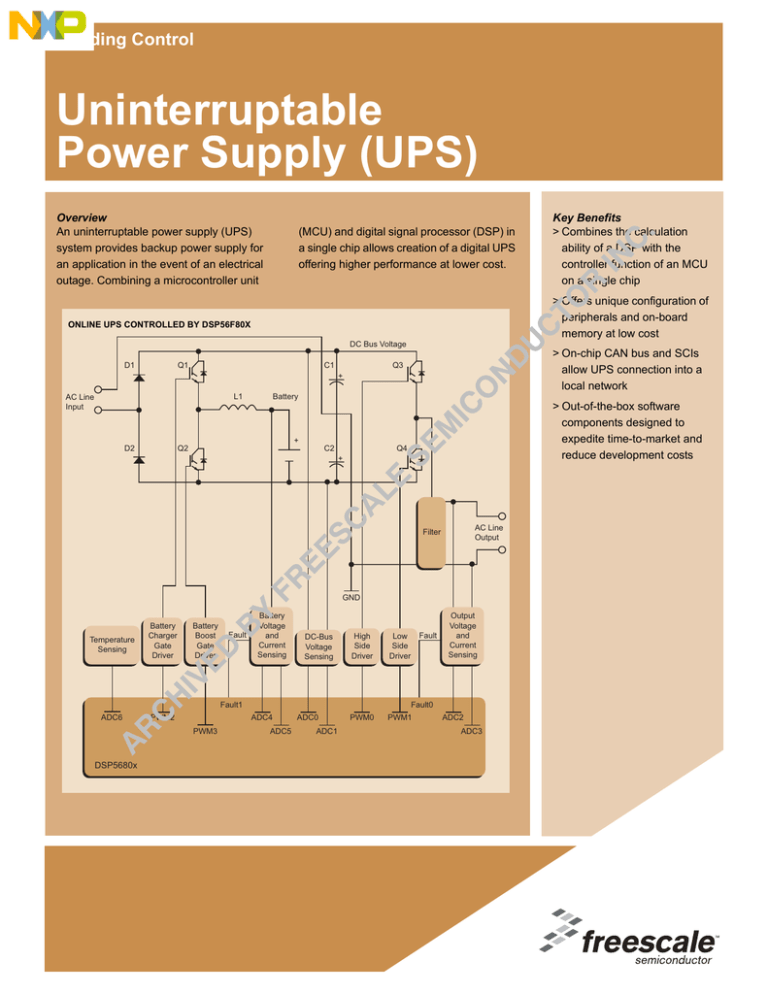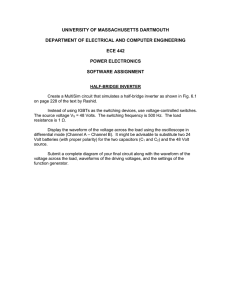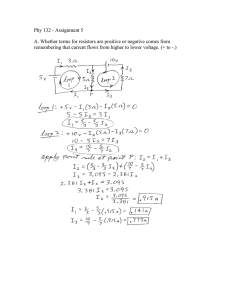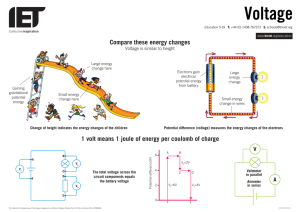
Building Control
Uninterruptable
Power Supply (UPS)
Overview
An uninterruptable power supply (UPS)
system provides backup power supply for
an application in the event of an electrical
outage. Combining a microcontroller unit
(MCU) and digital signal processor (DSP) in
a single chip allows creation of a digital UPS
offering higher performance at lower cost.
> Offers unique configuration of
peripherals and on-board
memory at low cost
ONLINE UPS CONTROLLED BY DSP56F80X
DC Bus Voltage
D1
C1
Q1
> On-chip CAN bus and SCIs
allow UPS connection into a
local network
Q3
+
L1
AC Line
Input
Battery
> Out-of-the-box software
components designed to
expedite time-to-market and
reduce development costs
+
D2
C2
Q2
Q4
+
AC Line
Output
Filter
GND
Temperature
Sensing
Battery
Charger
Gate
Driver
Battery
Boost
Gate
Driver
Fault
Battery
Voltage
and
Current
Sensing
DC-Bus
Voltage
Sensing
PWM2
Low
Side
Driver
PWM0
PWM1
DSP5680x
Output
Voltage
and
Current
Sensing
Fault0
ADC4
PWM3
Fault
High
Side
Driver
Fault1
ADC6
Key Benefits
> Combines the calculation
ability of a DSP with the
controller function of an MCU
on a single chip
ADC5
ADC0
ADC1
ADC2
ADC3
Freescale Ordering Information
Part Number
Product Highlights
Additional Information
DSP56F803
80 MHz, 40 MIPS, CAN, SCI, SPI, ADC, PWMs, Quadrature Decoder,
Quad Timer and
> 31.5K Program Flash
> 512K Program RAM
> 4K Data Flash
> 2K Data RAM
MCU-friendly instruction set, OnCE for debug, onchip relaxation oscillator, 2K BootFLASH, external
memory expansion, and up to 16 GPIO available in
a 100-pin LQFP
DSP56F805
80 MHz, 40 MIPS, CAN, SCIs, SPI, ADC, PWMs, Quadrature Decoder,
Quad Timer and
> 31.5K Program Flash
> 512K Program RAM
> 4K Data Flash
> 2K Data RAM
MCU-friendly instruction set, OnCE for debug, onchip relaxation oscillator, 2K BootFLASH, external
memory expansion, and up to 32 GPIO available in
a 144-pin LQFP
DSP56F807
80 MHz, 40 MIPS, CAN, SCIs, SPI, ADCs, PWMs, Quadrature Decoder,
Quad Timer and
> 60K Program Flash
> 2K Program RAM
> 8K Data Flash
> 4K Data RAM
MCU-friendly instruction set, OnCE for debug, onchip relaxation oscillator, 2K BootFLASH, external
memory expansion, and up to 32 GPIO available in
both a 160-pin LQFP and 160 MAPBGA
MC56F8300 Family
60 MHZ, 60 MIPS, up to 576KB Flash, 36KB RAM, and Off-Chip Memory, SCI,
SPI, ADC, PWM, Quadrature Decoder, Quad Timer, FlexCAN, GPIO, COP/
Watchdog, PLL, MCU-style software stack support, JTAG/OnCE for debug,
temperature sensor
www.freescale.com
MC56F8100 Family
40 MHZ, 40 MIPS, up to 544KB Flash, 32KB RAM, and Off-Chip Memory, SCI,
SPI, ADC, PWM, Quadrature Decoder, Quad Timer, FlexCAN, GPIO, COP/
Watchdog, PLL, MCU-style software stack support, JTAG/OnCE for debug
www.freescale.com
Design Challenges
Although the UPS has traditionally been
designed as analog circuitry, digital
UPSs are now preferred. These devices
use low-cost MCUs or DSPs and offer
sophisticated control algorithms with
highly flexible software, the ability to add
user interfaces, reduce components,
introduce testing procedures, and
increase reliability.
Several basic UPS topologies exist,
differentiated by function during a power
outage. The online UPS offers the
greatest reliability and continuity of
power supply. During normal operation,
SG2070-2
the load is connected to an inverter
powered by a battery and/or another
inverter. If a power outage occurs, the
inverter is supplied by the battery with no
switching or switching delay.
Freescale Semiconductor Solution
The Freescale Semiconductor Digital
Signal Controllers are well-suited for
digital UPS control, combining the DSP’s
calculation ability with the MCU’s
controller function on a single chip. Each
of the family members offers a unique
configuration of peripherals and onboard memory.
The figure on page 1 shows an online
UPS controlled by Freescale
Semiconductor DSP56F80x. This design
produces an optimal UPS system
through use of a single DSP56F80x
controller. The controller monitors all
necessary parameters, such as voltage,
current, and temperature, and controls
individual subsystems. The sensing
blocks contain simple circuitry that brings
the measurements within the range of
the analog-to-digital converters (ADCs).
Details of basic blocks, peripheral
utilization, and a brief software
description follow.
AC/DC Converter
An AC/DC converter generates the DC
bus voltage of the UPS. The rectifier
supplies both the AC output current and
the battery-charging current. The
simplest AC/DC converter is a standard
half-bridge rectifier, containing two
diodes (D1, D2), and requires no control
means. The advantage is a simple but
reliable design. The drawback is a
nonsinusoidal input current with high
harmonic content and electromagnetic
interference (EMI) that becomes more
apparent in high-power systems. If
sinusoidal input current is required,
implement a DSP-controlled active
power factor correction (PFC) circuit.
DC/AC Inverter
The DC/AC inverter generates AC output
voltage, which must be sinusoidal with
specific frequency (50 Hz or 60 Hz) and
amplitude (equal to the main line
voltage). The inverter contains two
power switches in a half-bridge
configuration with antiparallel diodes
(Q3, Q4). Both power devices (isolating
gate bipolar transistors, or IGBTs) are
controlled by the device through drivers
using pulse width modulation (PWM).
When filtered, sinusoidal output voltage
is generated. The limitation of this
topology is the amplitude of the
generated sinusoidal voltage that
depends on the DC bus voltage level.
The AC UPS output voltage is
approximately equal to the AC UPS input
voltage:
Vrms_out ≅ Vrms_in
The power devices and the output filter
create a voltage drop of several volts,
which is within the AC voltage tolerance.
If a more precise output voltage is
required, a voltage transformer can be
added to the UPS output. The voltage
level of the battery is not critical,
because the DC/DC boost converter
SG2070-3
(see below) can increase the voltage to
the required DC bus voltage level.
The device generates sinusoidal
modulated complementary PWM pulses
on channels PWM 0 and PWM 1. Due to
the limited turn-on and turn-off time of
the power switches, the dead-time
inserted between complementary
switching instances disables burn-out of
the inverter. To be out of the audible
noise, the switching PWM frequency
must be about 16–20 kHz. The
DSP56F80x on-chip PWM module with
dedicated hardware circuitry meets
these requirements, containing
complementary PWM channels with
dead-time, protection block, and other
features.
The algorithm controls the output voltage
using voltage control loop, current
control loop, and sine wave generation.
The algorithm requires voltage and
current feedback, so simple voltage and
current sensors detect the appropriate
analog values. The on-chip ADC reads
voltage on ADC2 and current on ADC3
in appropriate instances given by the
control loop time constants. The inverter
also contains circuitry to protect against
output overcurrent. Output current is
compared with the maximum allowed
value, and the generated fault signal is
fed to the fault input, Fault 0. If
overcurrent is detected, the inverter is
disabled and the main relay switches on
the AC bypass.
DC/DC Converter
The DC/DC converter accommodates
two basic functions: charging the battery
when required and providing the
appropriate level of DC bus voltage for
the inverter if the main line is
disconnected. Often battery voltage is
lower than DC bus voltage, so the
DC/DC converter increases the voltage
appropriately. The hardware circuitry
contains an IGBT half-bridge with
antiparallel diodes. Both transistors of
the half-bridge are controlled from the
PWM unit. The PWM channels are set to
independent edge-aligned mode, which
controls the power switches individually.
Overcurrent protection circuitry is
available. The PWM unit can control the
fault handling from individual fault inputs
separately, so even if the DC/DC
converter faults, the DC/AC inverter
operation continues if DC bus voltage is
present. The battery is protected from
high temperature: its temperature is
sensed by the ADC (ADC6) and fault
state is evaluated. The IGBT half-bridge
is used for both charging and boost
operations as described below:
> Battery Charger. The battery
charger charges the battery from the
DC bus. The battery’s voltage and
charging current are sensed by the
voltage sensor (ADC5) and the
current sensor (ADC4) connected to
the ADC. The control algorithm
controls the charging current through
PWM module on the upper power
switch (Q1) of the bridge (PWM2).
The lower switch (Q2) is permanently
switched off in this mode.
> Boost Converter. The boost
converter supplies the DC bus from
the battery through inductance L1.
The boost current and DC bus voltage
are sensed by the voltage (ADC0,
ADC1) sensors and current (ADC4)
sensor. The control algorithm controls
the DC bus voltage through PWM
module on the lower power switch
(Q2) of the bridge (PWM3). The upper
switch (Q1) is permanently switched
off in this mode of operation, so it
operates as a standard boost
converter.
Development Tools
Tool Type
Product Name
Vendor
Description
Software
CW568X
Freescale Semiconductor
CodeWarrior™ Development Studio for 56800/E Controllers with
Processor Expert (Metrowerks)
Software
Processor Expert
Freescale Semiconductor
Software infrastructure that allows development of efficient, highlevel software applications that are fully portable and reusable
across all 56800/E family of processors.
Software
CWDSP56800
Freescale Semiconductor
CodeWarrior Software Development Tools for 56800 (Metrowerks)
Hardware
56F800DEMO
Freescale Semiconductor
56F800 Demonstration Kit
Hardware
DSP56F803EVM
Freescale Semiconductor
Evaluation Module for the 56F803
Hardware
DSP56F805EVM
Freescale Semiconductor
Evaluation Module for the 56F805
Hardware
DSP56F807EVM
Freescale Semiconductor
Evaluation Module for the 56F807
Hardware
MC56F8300DSK
Freescale Semiconductor
56F8300 Developers Start Kit
Hardware
MC56F8367EVM
Freescale Semiconductor
Evaluation Module for the 56F834x, 56F835x, 56F836x
Development Kit
DSPOSRTOS
Freescale Semiconductor
Emulation Support for 56F80x Processors (Requires Ethernet
Network)
Disclaimer
This document may not include all the details necessary to completely develop this design. It is provided as a reference only and is
intended to demonstrate the variety of applications for the device.
Learn More: Contact the Technical Information Center at +1-800-521-6274 or +1-480-768-2130.
For more information about Freescale products, please visit www.freescale.com.
Freescale™ and the Freescale logo are trademarks of Freescale Semiconductor, Inc.
All other product or service names are the property of their respective owners.
© Freescale Semiconductor, Inc. 2005. All rights reserved.
SG2070
REV 4
6/2005
June2005





